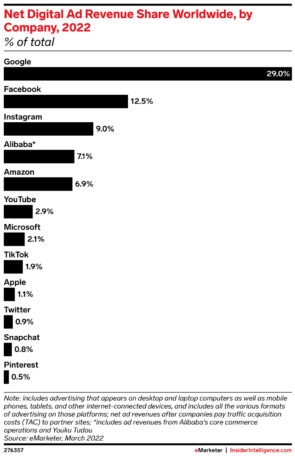As Meta heads into Q2 earnings, it faces a perfect storm of threats
As Facebook-parent Meta prepares to announce its second-quarter earnings next week, the company’s future has rarely looked so shaky. The company is facing negative macrotrends; a tightening ad market; less ability to track users; and a dearth of new, young users.
“In all the years I’ve been covering Meta, this is the most concerned I’ve ever been about the company’s future,” wrote Debra Aho Williamson, principal analyst at Insider Intelligence, in a research note Thursday, summing up the anxiety many investors are feeling about Meta stock, which has already lost half its value this year.
Despite all of Meta’s talk about building a metaverse, the company is still almost entirely sustained by its advertising business. It harvests a unique and extensive set of signal data from users in order to target ads to them within its apps. The social ads have long been a cost-effective way for marketers, big and small, to reach large, finely segmented audiences. But Meta’s ability to continue doing that seems less than certain.
“I used to say . . . the Facebook user base was still growing, even in the face of major scandals like Cambridge Analytica, as evidence that the company would continue to thrive and beat back any obstacles that stood in its way,” Williamson wrote. “Now Meta is losing its grip on its massive audience.” In the final quarter of 2021, Facebook’s global daily user count declined for the first time in the company’s 18-year history.

Meta’s U.S. user base is showing very little growth in user attention. According to Morgan Stanley equity researchers, the total time users spent on Meta sites/apps during the second quarter was down 1% from the same quarter last year. In this quarter, time spent on Facebook fell 3% compared to last year’s Q2, the researchers found. Instagram has remained more attractive to young users, but Williamson says even that app is showing softness in growing its younger user base.
To keep advertisers happy, Meta must reverse those trends, but it’s facing a number of serious barriers to doing that.
Economic headwinds
First, macro effects, such as inflation and the threat of recession, are adversely affecting the normal flow of ad dollars, as marketers are spending more carefully. This trend was reflected when Snap, which competes for interactive ad dollars with Meta, was punished by investors Thursday after reporting less than stellar Q2 ad revenue, despite having user growth remain solid. Snap’s stock fell 32%. Meta—being in the exact same business—saw its stock fall 5.7% as well.
What is Meta today?
It’s no secret that Facebook is getting thumped by TikTok when it comes to attracting young people and keeping them engaged for longer periods of time. One study says young users were spending an average of 91 minutes per day watching TikTok videos by the end of last year.
Mimicking TikTok might not even help the bottom line.
Now Meta, which has a history of blatantly copying its competitors’ successful products and features, is redesigning Facebook and Instagram apps to put its TikTok-like Reels videos in front of eyeballs more often. In fact, the apps appear to be increasingly designed around Reels.
Meta CEO Mark Zuckerberg likes to talk about “connecting the world” and the importance of personal communications with family and friends, but abruptly reorienting around Reels seems out of sync with this mission. With the redesign, Facebook will show users less content from friends and family and more short videos and stories from creators they don’t know. Making that shift without disorienting users won’t be easy.
Mimicking TikTok might not even help the bottom line. The Morgan Stanley analysts say this tactic has indeed improved eyes-on time, but they worry that it could ultimately hurt ad revenues unless Meta figures out how to wring more money out of Reels. “In our view . . . efforts to emphasize Reels speak to a rising tactical risk of Reels engagement being more cannibalistic to near-term time and revenue (given Reels still monetizes at significantly lower rates than core Feed/Stories offerings),” the researchers wrote in a recent investor note.
Apple’s app transparency
Then there’s the Apple problem.
The effectiveness of Meta’s ads has always depended on the fine-grained personal preference data the company gathers from users’ movements on its apps and around the web. But now that Apple has given users of its devices the ability to opt out of such tracking, Meta’s ability to match ads with specific user groups has been blunted. And the results are showing, as advertisers reassess the real cost-effectiveness of the ads.
Add all of this up—worsening economic headwinds, identity issues (what is Meta today?), and limited ad-targeting ability—and you have a challenging business environment for a company that once seemed unassailable. We’ll learn more about how it’s faring next Wednesday when Meta announces its earnings and holds its call with analysts after market close.
(30)


